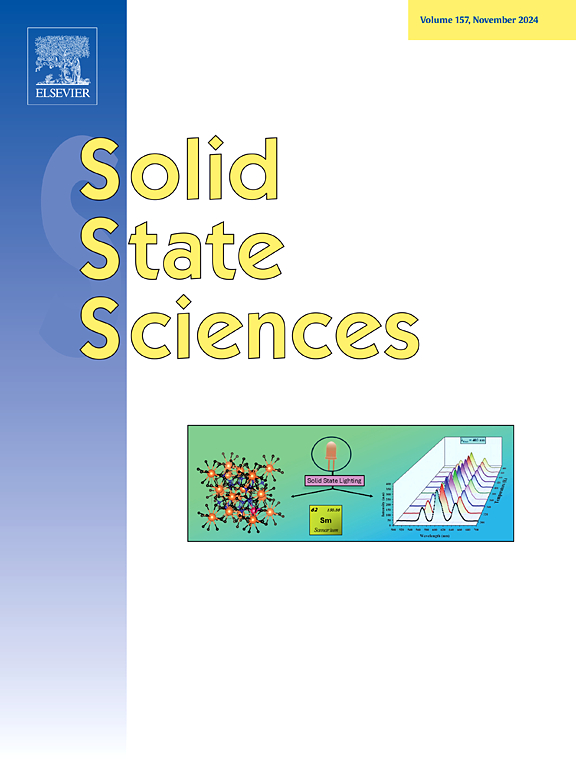fes2掺杂的MoS2纳米花具有优势的1T-MoS2相,可增强过氧化物酶活性
IF 3.4
3区 化学
Q2 CHEMISTRY, INORGANIC & NUCLEAR
引用次数: 0
摘要
与天然酶相比,具有过氧化物酶活性的纳米酶的催化活性较低。因此,开发和设计具有高催化活性的人工酶具有重要意义。以anderson型多金属氧酸盐(FeMo6)为前驱体,采用水热法制备了fes2掺杂二硫化钼(FeS2-MoS2)纳米花。FeS2-MoS2的x射线光电子能谱(XPS)和拉曼光谱证实了1T-MoS2相的存在。通过控制反应时间,合成了不同1T/2H-MoS2相比的FeS2-MoS2。FeS2-MoS2作为纳米酶,可以促进3,3 ',5,5 ' -四甲基联苯胺(TMB)氧化为oxTMB,具有过氧化物酶活性。与其他反应时间制备的样品相比,反应时间为12 h的FeS2-MoS2表现出更高的过氧化物酶活性。FeS2-MoS2的催化活性是MoS2的3倍。FeS2-MoS2对H2O2的Km值是辣根过氧化物酶(HRP)的110倍,说明FeS2-MoS2对H2O2具有更好的亲和力。优异的催化活性可能与双金属的协同作用、较大的比表面积、高的1T-MoS2含量(77.52%)和缺陷有关。据我们所知,FeS2-MoS2纳米花对H2O2的检测限极低,仅为0.52 μM。本研究提出了一种制备高性能纳米酶催化剂的新方法。本文章由计算机程序翻译,如有差异,请以英文原文为准。

FeS2-doped MoS2 nanoflower with the dominant 1T-MoS2 phase for enhanced peroxidase activity
Nanozymes with peroxidase activity have lower catalytic activity compared to natural enzymes. Therefore, it is of great significance to develop and design artificial enzymes with high catalytic activity. FeS2-doped MoS2 (FeS2-MoS2) nanoflower is synthesized via a hydrothermal method, using Anderson-type polyoxometalates (FeMo6) as precursors. The X-ray photoelectron spectroscopy (XPS) and Raman spectrum of FeS2-MoS2 confirm the presence of the 1T-MoS2 phase. FeS2-MoS2 with different 1T/2H-MoS2 phase ratios are synthesized by controlling the reaction time. As a nanozyme, the obtained FeS2-MoS2 can promote the oxidation of 3,3′,5,5′-tetramethylbenzidine (TMB) to oxTMB, showing peroxidase activity. FeS2-MoS2 at a reaction time of 12 h exhibits higher peroxidase activity compared to samples prepared at other reaction times. The catalytic activity of FeS2-MoS2 is 3 times that of MoS2. The Km value for H2O2 was 110 times that of horseradish peroxidase (HRP), indicating that the FeS2-MoS2 had a better affinity for H2O2. The excellent catalytic activity may be due to the synergistic effect of bimetal, larger specific surface area, the high content of 1T-MoS2 (77.52 %) and defect. As far as we know, the FeS2-MoS2 nanoflower exhibits an exceptionally low detection limit of 0.52 μM for the colorimetric sensing of H2O2. This research presents a novel approach for creating high-performing nanozyme catalysts.
求助全文
通过发布文献求助,成功后即可免费获取论文全文。
去求助
来源期刊

Solid State Sciences
化学-无机化学与核化学
CiteScore
6.60
自引率
2.90%
发文量
214
审稿时长
27 days
期刊介绍:
Solid State Sciences is the journal for researchers from the broad solid state chemistry and physics community. It publishes key articles on all aspects of solid state synthesis, structure-property relationships, theory and functionalities, in relation with experiments.
Key topics for stand-alone papers and special issues:
-Novel ways of synthesis, inorganic functional materials, including porous and glassy materials, hybrid organic-inorganic compounds and nanomaterials
-Physical properties, emphasizing but not limited to the electrical, magnetical and optical features
-Materials related to information technology and energy and environmental sciences.
The journal publishes feature articles from experts in the field upon invitation.
Solid State Sciences - your gateway to energy-related materials.
 求助内容:
求助内容: 应助结果提醒方式:
应助结果提醒方式:


